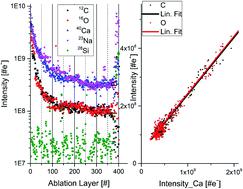当前位置:
X-MOL 学术
›
J. Anal. At. Spectrom.
›
论文详情
Our official English website, www.x-mol.net, welcomes your
feedback! (Note: you will need to create a separate account there.)
Determination of the microscopic mineralogy of inclusion in an amygdaloidal pillow basalt by fs-LIMS
Journal of Analytical Atomic Spectrometry ( IF 3.1 ) Pub Date : 2020-11-10 , DOI: 10.1039/d0ja00390e Marek Tulej 1, 2, 3, 4 , Rustam Lukmanov 1, 2, 3, 4 , Valentine Grimaudo 1, 2, 3, 4 , Andreas Riedo 1, 2, 3, 4 , Coenrad de Koning 1, 2, 3, 4 , Niels F. W. Ligterink 4, 5, 6 , Anna Neubeck 7, 8, 9 , Magnus Ivarsson 9, 10, 11 , Sean McMahon 12, 13, 14, 15 , Peter Wurz 1, 2, 3, 4
Journal of Analytical Atomic Spectrometry ( IF 3.1 ) Pub Date : 2020-11-10 , DOI: 10.1039/d0ja00390e Marek Tulej 1, 2, 3, 4 , Rustam Lukmanov 1, 2, 3, 4 , Valentine Grimaudo 1, 2, 3, 4 , Andreas Riedo 1, 2, 3, 4 , Coenrad de Koning 1, 2, 3, 4 , Niels F. W. Ligterink 4, 5, 6 , Anna Neubeck 7, 8, 9 , Magnus Ivarsson 9, 10, 11 , Sean McMahon 12, 13, 14, 15 , Peter Wurz 1, 2, 3, 4
Affiliation

|
We present chemical depth profiling studies on mineralogical inclusions embedded in amygdale calcium carbonate by our Laser Ablation Ionisation Mass Spectrometer designed for in situ space research. An IR femtosecond laser ablation is employed to generate ions that are recorded by a miniature time-of-flight mass spectrometer. The mass spectra were measured at several locations on the sample surface and yield chemical depth profiles along the depth length of about 30 μm. The presence of oxides and sulphides within inclusion material allows us to derive elemental abundance calibration factors (relative sensitivity coefficients, RSCs) for major and minor elements. These are obtained from the atomic intensity correlations performed on the depth profiling data. With the RSCs corrections the quantitative analysis of more complex mineralogical phases within the inclusion is conducted by correlating atomic abundance fractions in ternary diagrams, typically used in geology. The spatial resolution of the depth profiles was sufficient to study chemically distinct micrometre-sized objects, such as mineralogical grains and thin layers of minerals including micrometre-sized filamentous structures. The method presented here is well-suited for the quantitative chemical analyses of highly heterogeneous materials where the ablation condition can vary locally with the material composition making the application of standard reference materials less accurate. The presented method is developed to distinguish between abiotic and biological material while searching for micrometre-sized extinct or extent life forms on the surfaces of Solar System bodies.
中文翻译:

用fs-LIMS测定杏仁状枕形玄武岩中夹杂物的微观矿物学
我们通过专为现场设计的激光烧蚀电离质谱仪,对杏仁核碳酸钙中嵌入的矿物包裹体进行了化学深度分析研究空间研究。红外飞秒激光烧蚀用于产生由微型飞行时间质谱仪记录的离子。在样品表面的多个位置测量质谱,并沿着约30μm的深度长度产生化学深度分布。夹杂物中氧化物和硫化物的存在使我们能够导出主要和次要元素的元素丰度校准因子(相对灵敏度系数,RSC)。这些是从对深度剖析数据执行的原子强度关联中获得的。使用RSC校正后,通过关联通常在地质学中使用的三元图中的原子丰度分数,可以对夹杂物中更复杂的矿物相进行定量分析。深度剖面的空间分辨率足以研究化学上不同的微米级物体,例如矿物颗粒和包括微米级丝状结构的矿物薄层。这里介绍的方法非常适合于高度异质材料的定量化学分析,其中烧蚀条件会随材料成分的不同而局部变化,从而使得标准参考材料的应用不太准确。开发了提出的方法以区分非生物材料和生物材料,同时寻找太阳系物体表面上的微米级灭绝或扩展寿命形式。这里介绍的方法非常适合于高度异质材料的定量化学分析,其中烧蚀条件会随材料成分的不同而局部变化,从而使得标准参考材料的应用不太准确。开发了提出的方法以区分非生物材料和生物材料,同时寻找太阳系物体表面上的微米级灭绝或扩展寿命形式。这里介绍的方法非常适合于高度异质材料的定量化学分析,其中烧蚀条件会随材料成分的不同而局部变化,从而使得标准参考材料的应用不太准确。开发了提出的方法以区分非生物材料和生物材料,同时寻找太阳系物体表面上的微米级灭绝或扩展寿命形式。
更新日期:2020-11-27
中文翻译:

用fs-LIMS测定杏仁状枕形玄武岩中夹杂物的微观矿物学
我们通过专为现场设计的激光烧蚀电离质谱仪,对杏仁核碳酸钙中嵌入的矿物包裹体进行了化学深度分析研究空间研究。红外飞秒激光烧蚀用于产生由微型飞行时间质谱仪记录的离子。在样品表面的多个位置测量质谱,并沿着约30μm的深度长度产生化学深度分布。夹杂物中氧化物和硫化物的存在使我们能够导出主要和次要元素的元素丰度校准因子(相对灵敏度系数,RSC)。这些是从对深度剖析数据执行的原子强度关联中获得的。使用RSC校正后,通过关联通常在地质学中使用的三元图中的原子丰度分数,可以对夹杂物中更复杂的矿物相进行定量分析。深度剖面的空间分辨率足以研究化学上不同的微米级物体,例如矿物颗粒和包括微米级丝状结构的矿物薄层。这里介绍的方法非常适合于高度异质材料的定量化学分析,其中烧蚀条件会随材料成分的不同而局部变化,从而使得标准参考材料的应用不太准确。开发了提出的方法以区分非生物材料和生物材料,同时寻找太阳系物体表面上的微米级灭绝或扩展寿命形式。这里介绍的方法非常适合于高度异质材料的定量化学分析,其中烧蚀条件会随材料成分的不同而局部变化,从而使得标准参考材料的应用不太准确。开发了提出的方法以区分非生物材料和生物材料,同时寻找太阳系物体表面上的微米级灭绝或扩展寿命形式。这里介绍的方法非常适合于高度异质材料的定量化学分析,其中烧蚀条件会随材料成分的不同而局部变化,从而使得标准参考材料的应用不太准确。开发了提出的方法以区分非生物材料和生物材料,同时寻找太阳系物体表面上的微米级灭绝或扩展寿命形式。










































 京公网安备 11010802027423号
京公网安备 11010802027423号